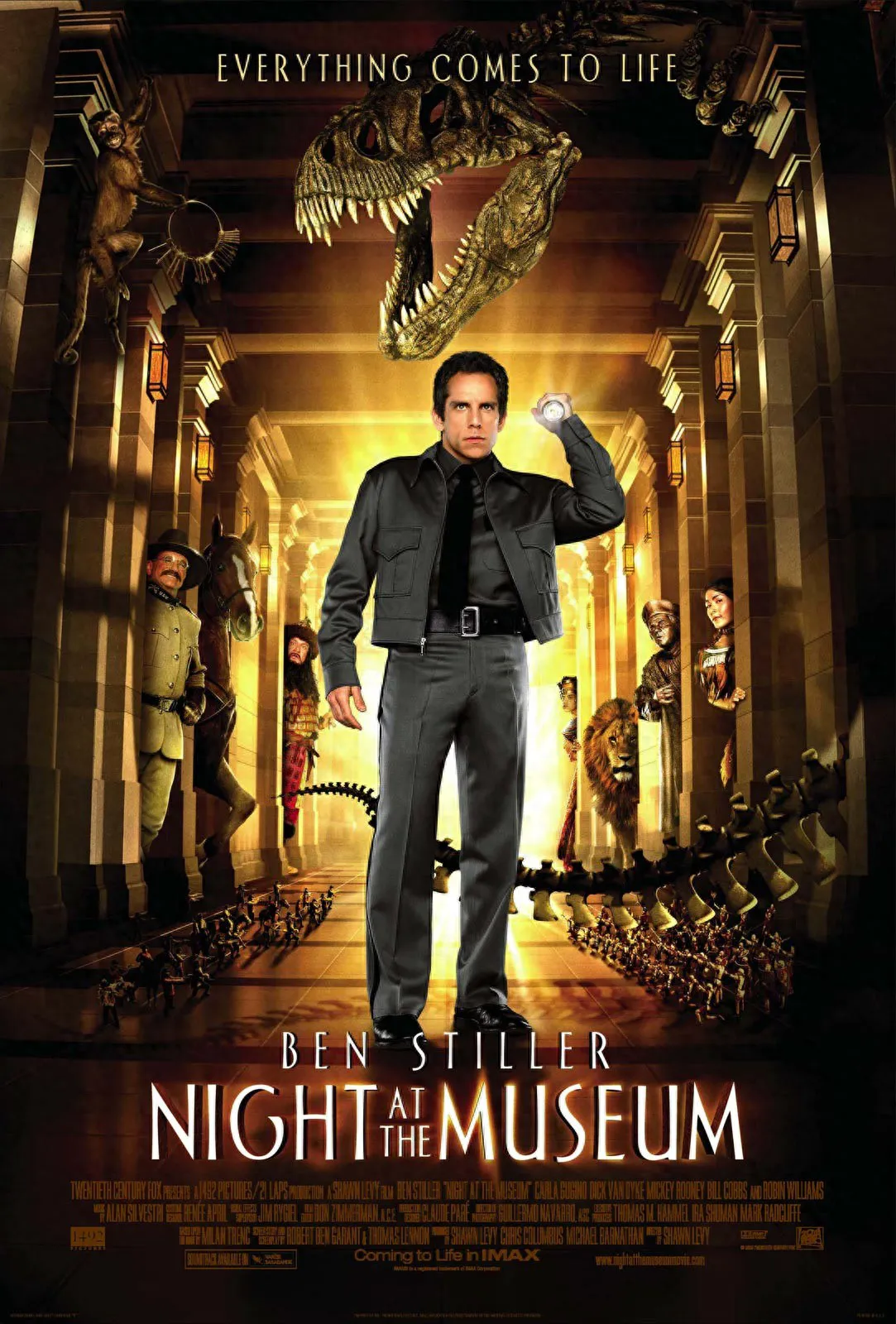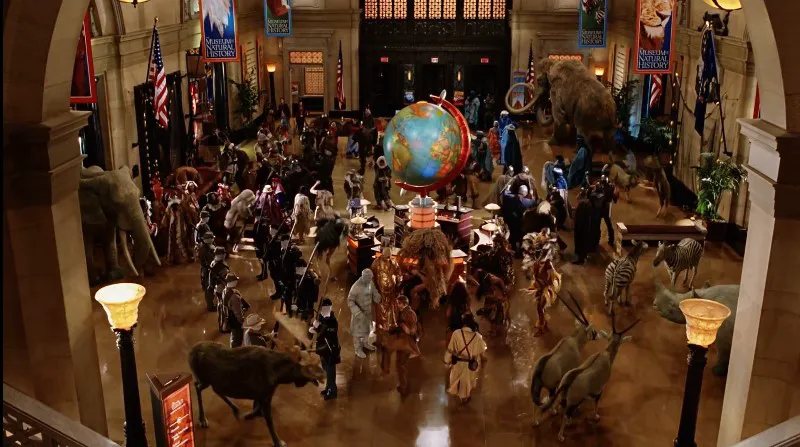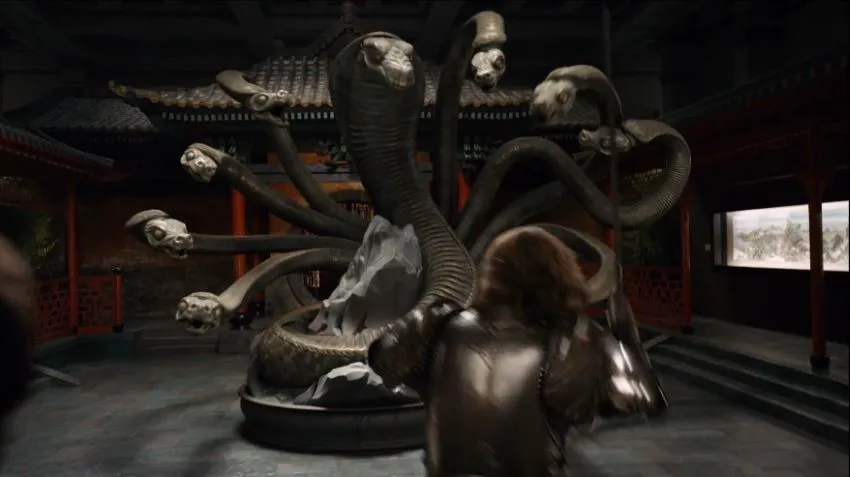Editor’s Note: A Nostalgic Dive
In recent years, museums in China have surged in popularity as destinations for leisure and cultural exploration. Increasingly, these institutions are leveraging technologies like AR and VR to “revive” artifacts, offering visitors more interactive and immersive experiences. This trend evokes memories of the once-ubiquitous “Night at the Museum” film series, where museum exhibits magically come to life at night, mirroring the increasingly diverse and engaging museum experiences of today.

Poster of “Night at the Museum”
The Heart of the Story: Classic Heroism
At its core, “Night at the Museum” embraces the familiar tropes of Hollywood heroism. The story begins with Larry, a newly hired night watchman, discovering that the museum’s exhibits come to life after dark. He is initially overwhelmed as he struggles to maintain order. The conflict escalates when three former security guards attempt to steal the source of the magic – an ancient Egyptian stone tablet. Despite the chaos, Larry ultimately resolves the crisis, becoming a hero to the exhibits and finding personal fulfillment through his efforts.

The ending of “Night at the Museum”
This seemingly conventional narrative resonated with audiences, resulting in significant box office success. The original “Night at the Museum” (2006) grossed $575 million worldwide, followed by $413 million for “Night at the Museum 2” (2009), and $363 million for the concluding installment, “Night at the Museum 3” (2014). While visual effects played a role, the true appeal of the series lies in its unique premise. Compared to other movies at the time, like the Transformers movies, the CGI wasn’t anything special.
The Allure of the Unexpected
The film is set in the Natural History Museum, a place on the verge of obscurity. The characters, aside from Larry, are historical figures who are not well known, creating a sense of unfamiliarity that draws the audience into the story.
The juxtaposition of these figures from different eras creates comedic moments, such as the conflict between miniature figures of Octavius, the founder of the Roman Empire, and Jedediah Smith, an American explorer and cowboy. Historically, these two figures lived 19 centuries apart, making their interaction an anachronistic delight.
The film also features American explorers Lewis and Clark, Attila the Hun, Egyptian pharaoh Menkaure, and Christopher Columbus. However, Theodore Roosevelt stands out as a symbol of “American spirit.” His wax statue serves as a mentor to Larry, delivering Shakespearean-style lectures that resemble a leader’s guidance to the common man. As a naturalist and historian, Roosevelt is perfectly positioned as the protagonist’s savior within the museum setting.
The protagonist’s savior, Theodore Roosevelt
Sequels and Shifting Scenery
Despite a satisfying conclusion, Hollywood’s commercial imperatives led to sequels. The storylines evolved, with “Night at the Museum 2” focusing on saving the world from the resurrected Egyptian pharaoh Kahmunrah (a fictional character), and “Night at the Museum 3” centering on saving the magical tablet itself. However, the core elements of Hollywood heroism and happy endings remained consistent.
The villain of “Night at the Museum 2”, Kahmunrah
The sequels are notable for their expanded museum settings. While the original took place in New York’s Natural History Museum, the sequels moved to the Smithsonian Institution Archives in Washington, D.C., and the British Museum in London. These changes introduced a wider array of historical figures, from Albert Einstein to Ivan the Terrible and Napoleon Bonaparte (portrayed as antagonists), and even Xiangliu, the nine-headed serpent from Chinese mythology.
These settings create a sense of time travel, immersing viewers in a world where different historical periods and legendary tales converge. The museum becomes a microcosm of the world, blending history, culture, and fantasy. As one of the few Hollywood franchises centered around museums, “Night at the Museum” stands as a memorable and imaginative series.

“Xiangliu” in “Night at the Museum 3”
A Missed Opportunity?
The “Night at the Museum” concept could have continued indefinitely, given the vast number of world-renowned museums. The series ended after only three films, partly due to the passing of Robin Williams, who played Theodore Roosevelt. His farewell scene with Larry became a poignant farewell to the actor himself. However, the series may have also ended because the same actors and themes could have become tiresome. Ending the series with a complete story, allowing the magic tablet to remain in the British Museum, reuniting the Egyptian prince with his family, and keeping the original cast intact, was a wise decision.
Despite its conclusion, the “Night at the Museum” series leaves a sense of longing for what could have been. The blend of fantasy and history offers endless possibilities. The rich cultural heritage of Chinese museums, for example, could provide inspiration for similar films. Incorporating these elements into the “Night at the Museum” concept could lead to a grand, Eastern-inspired adventure, showcasing the unique charm of Chinese culture to audiences worldwide.